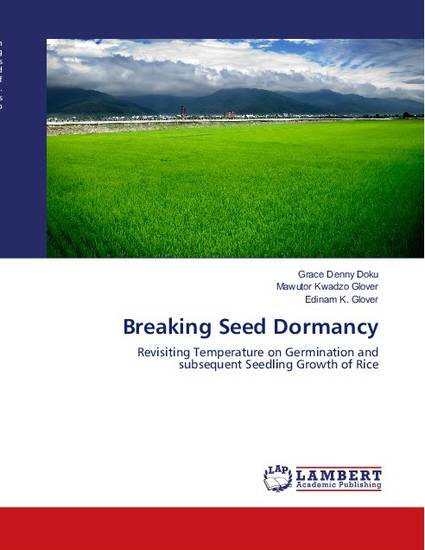
Book
Breaking Seed Dormancy: Revisiting Temperature on Germination and Subsequent Seedling Growth of Rice
(2018)
Abstract
Seeds of some mature rice variety fail to geminate when subjected to conditions under which seeds of other variety will germinate. This phenomenon is termed dormancy. One method of breaking dormancy in rice is to subject the ‘freshly’ matured seed to heat treatment. The main objective of this project was to find out if the temperature at which dormancy was broken would affect the subsequent performance of rice on the field in terms of plant stand (emergence), plant height and number of leaves produced. Previous work showed that the varieties TOG6565 (VI), CG17 (V2) and CG14 (V4), all of the species Oryza glaberrima (OG) exhibit dormancy after maturity. The variety WAB450-24-3-2-P18-HB (V10) which is an inter-specific hybrid, exhibit dormancy which could be partially broken at 50⁰ C for 4 days, and fully broken over a range of temperatures up to 80⁰ c for 4 days. The varieties TOG6565 (VI), CG17 (V2), WAB
450-24-2-5-P4-HB (V3) and CG14 (V4) were exposed to temperatures of 50⁰ C for 4 days and 80⁰c for 1, 2, 3 and 4 days, and temperature effects on their field performance studied in a randomized complete block design of three replicates *(i.e., a two factor experiment). The result indicated that differences in plant height and number of leaves produced three weeks after seeding as well as plant stand were insignificant with respect to temperature. Thus, the performance of the rice varieties with respect to the stated parameters when exposed to a temperature of 50⁰C for 4 days was not different from exposure to a temperature of 80⁰C for 4 days.
However, significant differences existed at 5% level of probability among the varieties with respect to plant height and the number of leaves produced but not with respect to plant stand.
This observation could be attributed to the unique characteristics of individual varieties, e.g., O glaberrima varieties are known to be more vigorous than their inter-specific progenies.
Work by a colleague showed that dormancy in O. glaberrima varieties is best broken at 60⁰C for 2 days. Based on the results reported here, It is recommended that this temperature (60⁰C for 2 days) can be safely used to break dormancy as exposure to higher temperatures (up to 80⁰C for 4 days) do not result in reduced plant performance. The ability of rice seed to tolerate high temperatures and still remain viable has also been proven.
Keywords
- Heat treatment,
- Number of leaves,
- Plant height,
- Plant stand,
- Rice (Oryza spp.),
- Seed dormancy,
- Temperature.
Disciplines
Publication Date
2018
Publisher
Germany: LAP Lambert Academic Publishing
ISBN
978-3659904066
Citation Information
Grace Denny Doku, Mawutor K. Glover and Edinam K. Glover 2018. Breaking Seed Dormancy: Revisiting Temperature on Germination and Subsequent Seedling Growth of Rice. Germany: LAP Lambert Academic Publishing.
